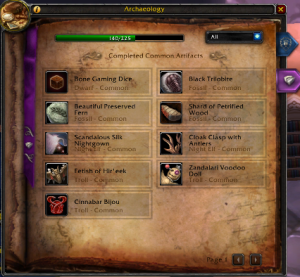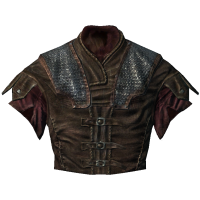What is Archaeogaming?
Let me begin at the beginning, a Level 1 n00b, but an archaeology “Master.” I was once a reluctant gamer who was dragged kicking and screaming into World of Warcraft […]
Exploring the archaeology in (and of) video games.
Let me begin at the beginning, a Level 1 n00b, but an archaeology “Master.” I was once a reluctant gamer who was dragged kicking and screaming into World of Warcraft […]
Let me begin at the beginning, a Level 1 n00b, but an archaeology “Master.” I was once a reluctant gamer who was dragged kicking and screaming into World of Warcraft (vanilla) and ended up losing myself in the virtual world, leveling to 70 the hard way (on my own, pugging instances, and without any mods). I played through Burning Crusade, Wrath of the Lich King, and Cataclysm. I quit before the release of Mists of Pandaria dropped. Why? Because I had a problem with the lore, the underlying story-history of the game-world.
As an archaeologist (B.A. in Classical Archaeology from the University of Evansville, M.A. in Classical Archaeology from the University of Missouri-Columbia), I am interested in how the game-world is built. This includes everything from architecture to humble pots. This also includes the story of the races within whatever game I play. Playing WoW was extremely satisfying to me because of the wealth of lore cooked up by the team at Blizzard (and from the fan community), and the depth of design for armor, weapons, and more. I was smitten. And when the Archaeology skill was unveiled within the Cataclysm expansion pack, I was elated. And then deflated. Those of you who have spent days leveling this skill know why: it’s boring, generally finds artifacts of little value, is repetitive, is time-consuming, but on occasion turns up something wonderful. But hey! Isn’t that what archaeology is?

Let’s take this farther for a moment. The thing that has pinned me to my basement office chair since 2012 is playing Skyrim (200 hours so far) as my first Elder Scrolls game, and *then* going backwards into Oblivion (no pun intended). As a “proper” archaeologist, I’m all of a sudden understanding more lore, and I must confess a preoccupation with Imperial accoutrements (pottery, armor, etc.), and how they appear in Oblivion compared to Skyrim where the Imperials have made headway into the land of the Nords. How does the design change, and why? I do plan on playing Morrowind next, going farther back in time, exploring a new geography, trying to follow threads within the lore while at the same time observing material culture of the NPCs and races in the game.


Back to WoW for a minute, I found it fascinating to be a part of history as the expansion packs came out and altered the world. But now I want to dip back into pre-MMO Warcraft itself. And the archaeologist in me wants to document everything, draw conclusions, and geek out with pattern recognition.
Surely there is a lore-master or game archivist at both Blizzard Entertainment and Bethesda Softworks. After reading Neal Stephenson’s Reamde and seeing one of these as a character, I do think it’s likely the case, unless the companies are relying on chat rooms and reddit, vel sim, to make sure they’ve got their story straight. But what of the design of simple pots, of peasant threads? Where do the designers go to see what came before, and how do they make decisions to carry those designs forward into the next world, or to abandon them for something new? We ask the same of ancient artisans as we study what was left behind.
When I play a game like Elder Scrolls IV or V, the archaeologist and explorer in me do a couple of things. First, I do a few quests and talk to *everyone*, all of the NPCs in a village or town to learn, learn, learn. I study. I collect. I read all those books. And then it’s off to the wilderness. My eye is always caught by unnatural (e.g., not nature-made) construction, so I investigate. I document.
In an MMO, I like to go off by myself to explore. I could care less (in my first explorations of a place) about gear sets and player-vs-player. Instead, I level up my toons so they are strong enough and geared enough to survive attacks and the environment, and then I go play. This drives guildies up the wall and disappoints a lot of other people who want to get on with things, but I dawdle inside instances, explore every nook and cranny, loot everything I can find (shameful behavior for an archaeologist, I know), but I also do try to help my guild or pick-up-group (PUG) defeat the bosses if only to find an epic or legendary piece of gear. One of the best compliments I ever received when running around Orgrimmar was from a random player who complimented me on a vintage axe that had dropped in Karazhan. I liked it because it was old. At level 85, it’s certainly useless for me as a weapon, but I like it. I found it. And it reminds me of an earlier time.

The archaeology of games is a very real thing and deserves a forum of its own for future exploration, speculation, and outright scholarship. I propose that the forum be here on the Archaeogaming blog. If a game has archaeology in it, let’s discuss it. But I would also like to apply archaeological methods in exploring how in-game cultures change between game iterations. There’s more to archaeogaming than that, and I hope to write about my experiences in exploring connections between archaeology and gaming here each week. I also invite readers to contribute. Drop a line to archaeogaming@gmail.com if you’d like to write a guest post or to review a game that has archaeology in it.
Andrew, GREAT post! Totally excited about this blog and can’t wait to read more of your ideas!
Reblogged this on Archaeology, Academia and Access and commented:
An excellent post by Andrew Reinhard on ‘Archaeogaming’ – Andrew organises his thoughts on archaeology and gaming most eloquently, and articulates some of the fuzzy, thought-shaped notions that have been bashing about my head for the past 6 months or so. This new blog is a must for anyone interested in the intersection of archaeology and games!
Thanks, Emily! There’s certainly a lot of ground to cover. You’re welcome to do a guest-post if you like, of course. For this blog, I don’t want to tie the archaeogaming concept to antiquity (either real or imagined), but instead to archaeology of any time period (past, present, future) for any culture (again, either real or imagined) in computer games (console, computer, mobile). What makes archaeology “fun” enough to introduce into games, but also, how can we use archaeological methods to fully explore iterations of games built within a shared world? How do games integrate cultural heritage sites into gameplay? And how do different types of games handle changing worlds, be these games RPGs, FPSs, side-scrollers, etc.? I think archaeogaming is part reception studies, but perhaps is “post-reception” as it gets beyond Classics and actually explores the game-space for what it is, and how game and player interact within that space within an archaeological context. Welcome to avoiding your formal thesis!
If you haven’t already played Morrowind you should. It is also a fascinating game and full of interesting stuff to explore. I think that a player can get better gaming experience when playing games if he knows things about history. I am very interested about medieval history and I am happy to discover references to history from Oblivion and Skyrim.
….very cool blog! I own a trowel that shoots lazers…. dings the lithics a bit and creates havoc on ceramics but hey, it’s cool. Good luck Emily and a safe 2014 in the field!